A Minor History of Giant Spheres
From CABINET
1664
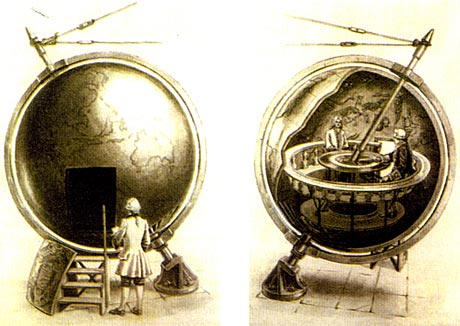
The Gottorp Globe, the world’s first modern planetarium, is completed in Germany. The hollow sphere, ten feet in diameter, is turned by water power; it has a map of the constellations on the interior and a map of the world on the outside. In 1714, it is given as a gift to Peter the Great but is destroyed by fire in 1747. The reconstructed globe, stolen by the Germans in World War II and recovered by US troops, now resides at the St. Petersburg Kunstkammer.
1699
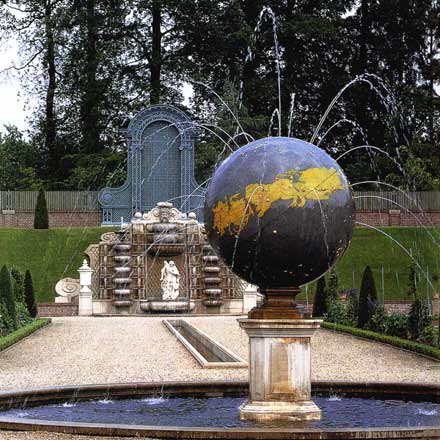
Daniel Marot completes the Celestial Sphere Fountain for the country palace of William of Orange and Princess Mary at Het Loo, the Netherlands. Marot’s spherical fountain is etched with a celestial map and spits water from a small hole in each star.
1784
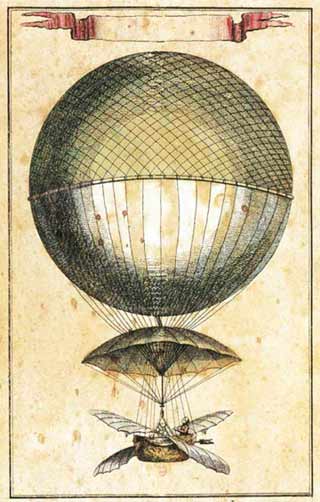
Jean-Pierre Blanchard’s spherical hydrogen balloon carries him across the river Seine.
1784
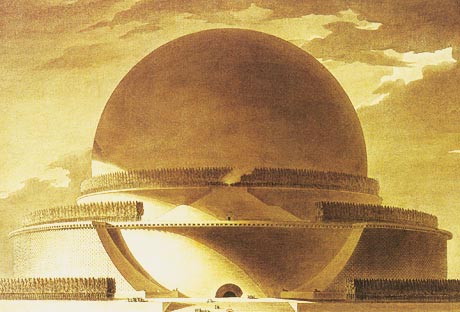
Visionary French architect Étienne-Louis Boullée designs his Cenotaph for Newton, a giant sphere punctured by holes that create the illusion of suspended stars. He writes, “O Newton! … I conceived the idea of surrounding thee with thy discovery, and thus, somehow, surrounding thee with thyself. … From whatever side we look at this shape, no trick of perspective can alter the magnificence of its perfect form … as soft and as flowing as it is possible to imagine.” Similarly believing that the sphere represents the most perfect expression of the sublime, fellow French architects Claude-Nicolas Ledoux, Jean-Jacques Lequeu, and Leon Vaudoyer all design spherical buildings during this period.
1850
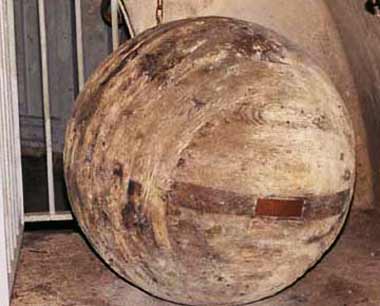
Baron Haussmann and engineer Eugène Belgrand design the modern Paris sewer system.The sewers are regularly cleaned using large wooden spheres just smaller than the system’s tubular tunnels. The buildup of water pressure behind the balls forces them through the tunnel network until they emerge somewhere downstream pushing a mass of filthy sludge. (Courtesy sewerhistory.org)
1851

James Wyld’s sixty-foot-tall, hollow, inside-out globe goes on display in Leicester Square, with a spiral staircase and viewing platforms running through the polar axis. Wyld’s concave projection is described by Punch magazine as “a geographical globule, which the mind can take in at one swallow."
1889
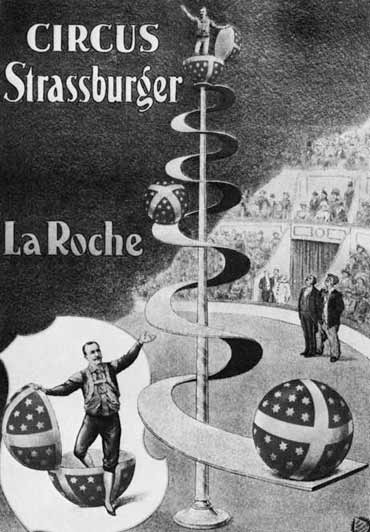
First documented appearance of the acrobat LaRoche’s “Wunderkugel” or “Bola Misteriosa” act. A hollow two-foot steel ball would ascend, apparently of its own accord, a narrow twenty-four-foot spiraling ramp and then descend just as perilously. At the end of the act, LaRoche would emerge from the sphere to reveal that he had in fact been propelling it by constantly shifting his center of gravity.
1895
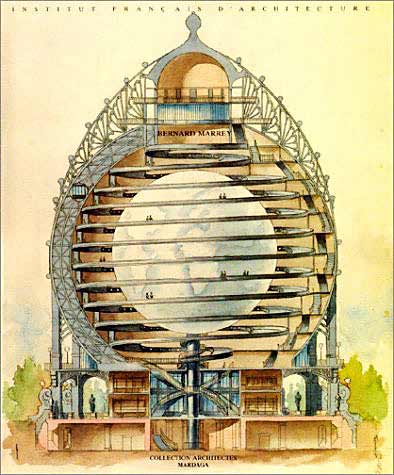
French geographer and anarchist Elisée Reclus proposes the construction of the largest inside-out globe yet, on the scale of 1:100,000. It would stand 418 feet tall and be regularly updated with the latest geographical information. Though the project receives modest support from Alfred Russel Wallace (who thought the globe need not be taller than 167 feet), and enthusiastic support from Patrick Geddes (who called it “no mere scientific model in its institute, but the image, the shrine, and temple of the Earth-mother”), it is never built.
1922
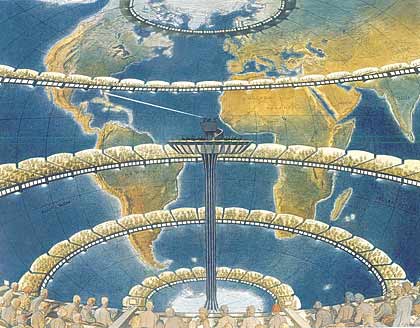
Meteorologist Lewis Fry Richardson, creator of the first dynamic model for weather prediction, proposes the creation of a “forecast factory” that would employ some 64,000 human computers sitting in tiers around the circumference of a giant globe. Each calculator would be responsible for solving differential equations related to the weather in his quadrant of the earth. From a pedestal in the center of the factory, a conductor would orchestrate this symphony of equations by shining a beam of light on areas of the globe where calculation was moving too fast or falling behind.
1930s
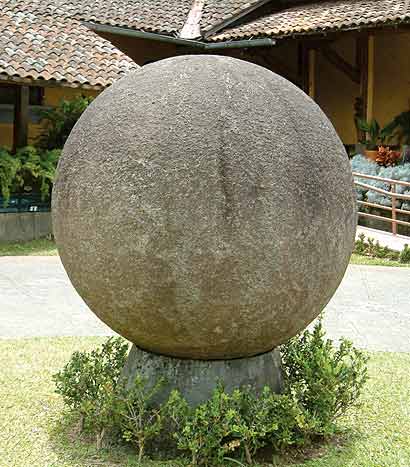
Workers from the United Fruit Company, clearing land in the Diquis Valley of Costa Rica, begin unearthing large numbers of almost perfectly round stone spheres. The largest of these apparently man-made balls is over six feet in diameter and weighs over sixteen tons. No one is sure exactly when or how they were made, or by whom, or for what reason, but according to University of Kansas archaeologist John Hoopes, “the balls were most likely made by reducing round boulders to a spherical shape through a combination of controlled fracture, pecking, and grinding.” Today, virtually all of the spheres have been taken from their original locations. Many are now prized lawn ornaments across Costa Rica.
1933
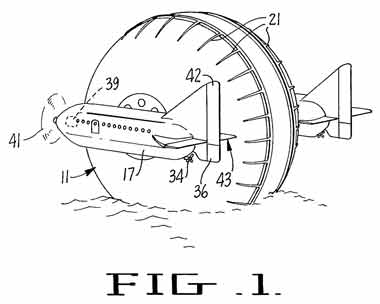
Alessandro Dandini of San Francisco receives a patent for his spherical marine vessel, a gigantic metal ball that rolls through the water with an attached passenger cabin. Popular Science reports, “The inventor expects his vessel to be used for amusement-park purposes and in addition be valuable for transport work.”
1934

William Beebe and Otis Barton descend more than half a mile beneath the surface of the ocean in the Bathysphere, a 4.75-foot steel ball fitted with three-inch—thick quartz windows. Their depth record stands for fourteen years.
1935
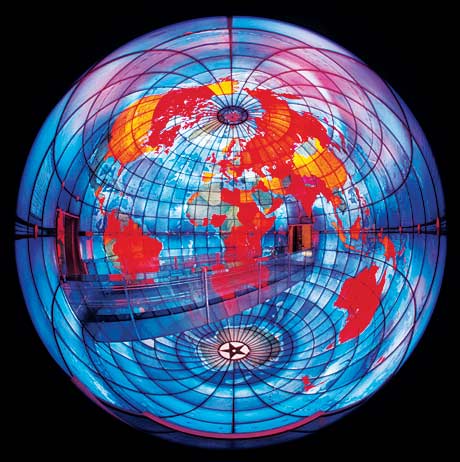
The three-story-tall stained glass Mapparium, an inside-out globe traversed by a glass bridge, opens at the Mary Baker Eddy Library in Boston. (Courtesy The Mary Baker Eddy Library, Boston, MA)
1939
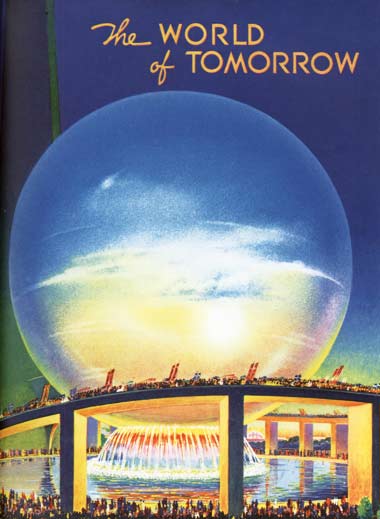
The centerpiece of the New York World’s Fair is a 700-foot triangular spire called the Trylon and the 180-foot tall Perisphere, a giant ball housing a model of a Utopian garden city of the future called “Democracity.” It is described in the official guide book as a “symbol of a perfectly integrated, futuristic metropolis pulsating with life and rhythm and music.”
1958
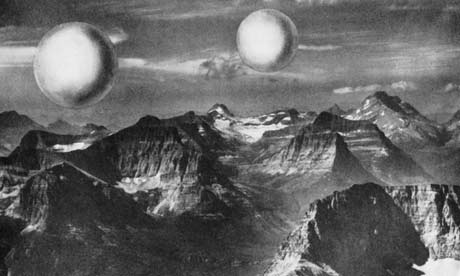
Buckminster Fuller proposes the “Cloud Nine” project, a levitating city of tensegrity spheres, each a mile in diameter. Because the surface-to-volume ratio of such spheres would be vanishingly small, Fuller calculated that if trapped solar energy raised their internal temperature by a mere one degree, they would be able to float like balloons.
1959
Physicist Freeman Dyson suggests that a giant shell of matter be constructed around a star to collect its total energy output. Dyson thought that the idea for such a sphere would be so self-evident to any advanced civilization that he suggested searching the skies for them as evidence of extra- terrestrial intelligence.
1960
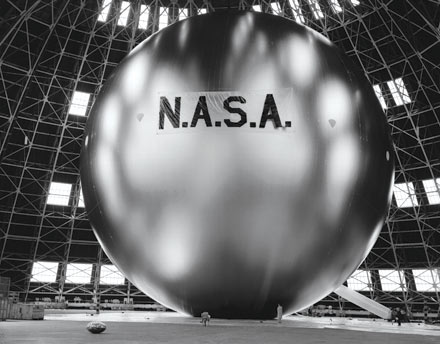
NASA launches Echo 1, America’s first communications satellite. The 100-foot mylar “satalloon” is coated in shiny, radio-reflective aluminum that allows it to passively bounce radio and television signals across the Atlantic.
1979
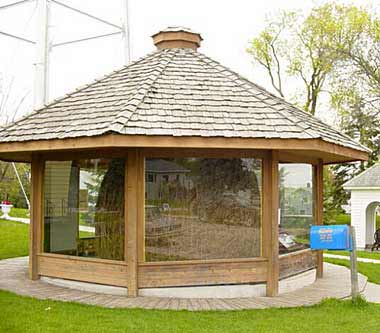
After spending four hours a day for twenty- nine years on the project, Francis Johnson finishes the world’s largest twine ball ever spun single-handedly. It weighs 18,000 pounds, has a circumference of forty feet, and is housed in an enclosed gazebo in Darwin, Minnesota, where “Twine Ball Day” is celebrated every August. (Courtesy Minnesota Historical Society)
1982
Spaceship Earth opens at Disney’s Epcot Center.
1984
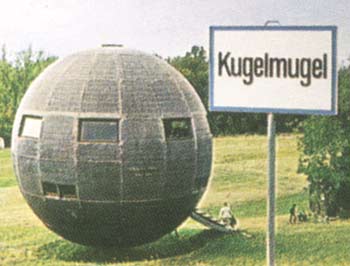
After a dispute with the Austrian government over the construction of his spherical house, Austrian artist Edwin Lipburger declares his property an independent nation and renames it the Republic of Kugelmugel. Lipburger is sentenced to jail for his refusal to pay taxes and insistence on printing his own stamps. However, a pardon from the Austrian president saves him from serving time.
1999
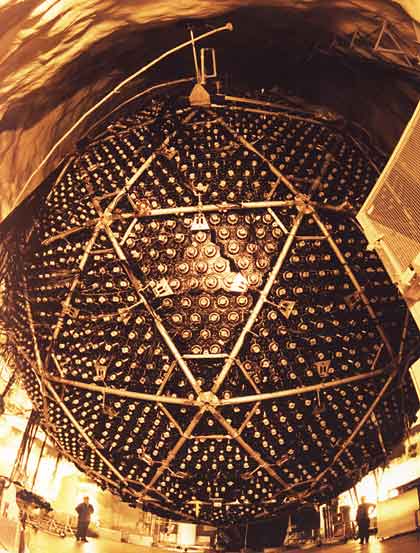
The Sudbury Neutrino Observatory begins operation more than a mile underground in an Ontario mine. The forty-foot sphere is filled with 1,000 tons of heavy water. Its purpose is to detect solar neutrinos.(Courtesy NASA)
2006
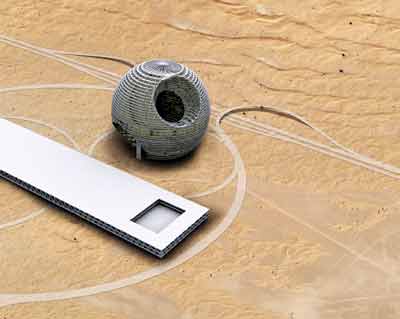
Rem Koolhaas offers a spherical design for the Ras al Khaimah Convention and Exhibition Centre in the UAE. Some critics note a striking resemblance to the planet-destroying Death Star from Star Wars. (Courtesy Office for Metropolitan Architecture/OMA)
1664

The Gottorp Globe, the world’s first modern planetarium, is completed in Germany. The hollow sphere, ten feet in diameter, is turned by water power; it has a map of the constellations on the interior and a map of the world on the outside. In 1714, it is given as a gift to Peter the Great but is destroyed by fire in 1747. The reconstructed globe, stolen by the Germans in World War II and recovered by US troops, now resides at the St. Petersburg Kunstkammer.
1699

Daniel Marot completes the Celestial Sphere Fountain for the country palace of William of Orange and Princess Mary at Het Loo, the Netherlands. Marot’s spherical fountain is etched with a celestial map and spits water from a small hole in each star.
1784

Jean-Pierre Blanchard’s spherical hydrogen balloon carries him across the river Seine.
1784

Visionary French architect Étienne-Louis Boullée designs his Cenotaph for Newton, a giant sphere punctured by holes that create the illusion of suspended stars. He writes, “O Newton! … I conceived the idea of surrounding thee with thy discovery, and thus, somehow, surrounding thee with thyself. … From whatever side we look at this shape, no trick of perspective can alter the magnificence of its perfect form … as soft and as flowing as it is possible to imagine.” Similarly believing that the sphere represents the most perfect expression of the sublime, fellow French architects Claude-Nicolas Ledoux, Jean-Jacques Lequeu, and Leon Vaudoyer all design spherical buildings during this period.
1850

Baron Haussmann and engineer Eugène Belgrand design the modern Paris sewer system.The sewers are regularly cleaned using large wooden spheres just smaller than the system’s tubular tunnels. The buildup of water pressure behind the balls forces them through the tunnel network until they emerge somewhere downstream pushing a mass of filthy sludge. (Courtesy sewerhistory.org)
1851

James Wyld’s sixty-foot-tall, hollow, inside-out globe goes on display in Leicester Square, with a spiral staircase and viewing platforms running through the polar axis. Wyld’s concave projection is described by Punch magazine as “a geographical globule, which the mind can take in at one swallow."
1889

First documented appearance of the acrobat LaRoche’s “Wunderkugel” or “Bola Misteriosa” act. A hollow two-foot steel ball would ascend, apparently of its own accord, a narrow twenty-four-foot spiraling ramp and then descend just as perilously. At the end of the act, LaRoche would emerge from the sphere to reveal that he had in fact been propelling it by constantly shifting his center of gravity.
1895

French geographer and anarchist Elisée Reclus proposes the construction of the largest inside-out globe yet, on the scale of 1:100,000. It would stand 418 feet tall and be regularly updated with the latest geographical information. Though the project receives modest support from Alfred Russel Wallace (who thought the globe need not be taller than 167 feet), and enthusiastic support from Patrick Geddes (who called it “no mere scientific model in its institute, but the image, the shrine, and temple of the Earth-mother”), it is never built.
1922

Meteorologist Lewis Fry Richardson, creator of the first dynamic model for weather prediction, proposes the creation of a “forecast factory” that would employ some 64,000 human computers sitting in tiers around the circumference of a giant globe. Each calculator would be responsible for solving differential equations related to the weather in his quadrant of the earth. From a pedestal in the center of the factory, a conductor would orchestrate this symphony of equations by shining a beam of light on areas of the globe where calculation was moving too fast or falling behind.
1930s

Workers from the United Fruit Company, clearing land in the Diquis Valley of Costa Rica, begin unearthing large numbers of almost perfectly round stone spheres. The largest of these apparently man-made balls is over six feet in diameter and weighs over sixteen tons. No one is sure exactly when or how they were made, or by whom, or for what reason, but according to University of Kansas archaeologist John Hoopes, “the balls were most likely made by reducing round boulders to a spherical shape through a combination of controlled fracture, pecking, and grinding.” Today, virtually all of the spheres have been taken from their original locations. Many are now prized lawn ornaments across Costa Rica.
1933

Alessandro Dandini of San Francisco receives a patent for his spherical marine vessel, a gigantic metal ball that rolls through the water with an attached passenger cabin. Popular Science reports, “The inventor expects his vessel to be used for amusement-park purposes and in addition be valuable for transport work.”
1934

William Beebe and Otis Barton descend more than half a mile beneath the surface of the ocean in the Bathysphere, a 4.75-foot steel ball fitted with three-inch—thick quartz windows. Their depth record stands for fourteen years.
1935

The three-story-tall stained glass Mapparium, an inside-out globe traversed by a glass bridge, opens at the Mary Baker Eddy Library in Boston. (Courtesy The Mary Baker Eddy Library, Boston, MA)
1939

The centerpiece of the New York World’s Fair is a 700-foot triangular spire called the Trylon and the 180-foot tall Perisphere, a giant ball housing a model of a Utopian garden city of the future called “Democracity.” It is described in the official guide book as a “symbol of a perfectly integrated, futuristic metropolis pulsating with life and rhythm and music.”
1958

Buckminster Fuller proposes the “Cloud Nine” project, a levitating city of tensegrity spheres, each a mile in diameter. Because the surface-to-volume ratio of such spheres would be vanishingly small, Fuller calculated that if trapped solar energy raised their internal temperature by a mere one degree, they would be able to float like balloons.
1959
Physicist Freeman Dyson suggests that a giant shell of matter be constructed around a star to collect its total energy output. Dyson thought that the idea for such a sphere would be so self-evident to any advanced civilization that he suggested searching the skies for them as evidence of extra- terrestrial intelligence.
1960

NASA launches Echo 1, America’s first communications satellite. The 100-foot mylar “satalloon” is coated in shiny, radio-reflective aluminum that allows it to passively bounce radio and television signals across the Atlantic.
1979

After spending four hours a day for twenty- nine years on the project, Francis Johnson finishes the world’s largest twine ball ever spun single-handedly. It weighs 18,000 pounds, has a circumference of forty feet, and is housed in an enclosed gazebo in Darwin, Minnesota, where “Twine Ball Day” is celebrated every August. (Courtesy Minnesota Historical Society)
1982
Spaceship Earth opens at Disney’s Epcot Center.
1984

After a dispute with the Austrian government over the construction of his spherical house, Austrian artist Edwin Lipburger declares his property an independent nation and renames it the Republic of Kugelmugel. Lipburger is sentenced to jail for his refusal to pay taxes and insistence on printing his own stamps. However, a pardon from the Austrian president saves him from serving time.
1999

The Sudbury Neutrino Observatory begins operation more than a mile underground in an Ontario mine. The forty-foot sphere is filled with 1,000 tons of heavy water. Its purpose is to detect solar neutrinos.(Courtesy NASA)
2006

Rem Koolhaas offers a spherical design for the Ras al Khaimah Convention and Exhibition Centre in the UAE. Some critics note a striking resemblance to the planet-destroying Death Star from Star Wars. (Courtesy Office for Metropolitan Architecture/OMA)

Comentários